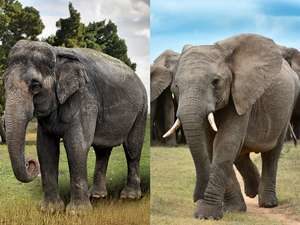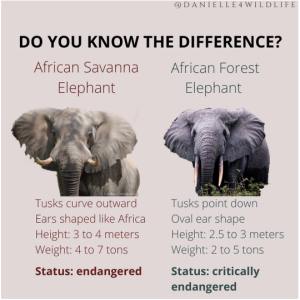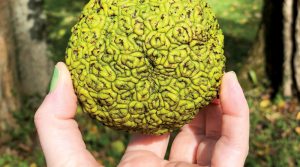Podcast: Play in new window | Download (Duration: 11:44 — 13.0MB)
Thanks to Connor and Pranav who suggested this week’s episode about elephants! It’s been too long since we had an elephant episode and there’s lots more to learn.
Further reading:
Asian elephants could be the maths kings of the jungle
A big difference between Asian and African elephants is diet
Study reveals ancient link between mammoth dung and pumpkin pie
The Asian elephant (left) and the African elephant (right):

The African bush elephant (left) and the African forest elephant (right) [photo taken from this page]:

The osage orange is not an orange and nothing wants to eat it these days:

Show transcript:
Welcome to Strange Animals Podcast. I’m your host, Kate Shaw.
We haven’t talked about elephants since episode 200! It’s definitely time for some elephant updates, so thanks to Conner and Pranav for their suggestions!
Conner suggested we learn more about the Asian elephant, which was one we talked about way back in episode 200. The biggest Asian elephant ever reliably measured was a male who stood 11.3 feet tall, or 3.43 meters, although on average a male Asian elephant, also called a bull, stands about 9 feet tall, or 2.75 meters. Females, called cows, are smaller. For comparison, the official height of a basketball hoop is 10 feet, or 3 meters. An elephant could dunk the ball every single time, no problem.
The Asian elephant used to live throughout southern Asia but these days it’s endangered and its range is reduced to fragmented populations in southeast Asia. There are four living subspecies recognized today although there used to be more in ancient times.
Elephants are popular in zoos, but the sad fact is that zoo elephants often don’t live as long as wild elephants, even with the best care. The elephant is adapted to roam enormous areas in a family group, which isn’t possible in captivity. In the wild, though, the elephant is increasingly endangered due to habitat loss and poaching. Even though the Asian elephant is a protected species, people kill elephants because their tusks are valuable as ivory. Tusks are a modified form of really big tooth, and it’s valuable to some people because it can be carved into intricate pieces of art that can sell for a lot of money. That’s it. That’s the main reason why we may not have any elephants left in another hundred years at this rate, because rich people want carvings made in a dead animal’s tooth. People are weird, and not always the good kind of weird.
In happier Asian elephant news, though, a 2018 study conducted in Japan using zoo elephants replicated the results of previous studies that show Asian elephants have numeric competence that’s surprisingly similar to that in humans. That means they understand numbers at least up to ten, and can determine which group of items has more or less items than another group. That sounds simple because humans are really good at this, but most animals can only understand numbers up to three. It goes one, two, three, lots.
Many animals do have a good idea of numbers in a general way even if they can’t specifically count. Gray wolves, for instance, know how many wolves need to join the hunt to successfully bring down different prey animals. Even the humble frog will choose the larger group of food items when two groups are available. But the Asian elephant seems to have an actual grasp of numbers. I specify the Asian elephant because studies with African elephants haven’t found the same numeric ability.
Elephants make a lot of sounds, such as the iconic trumpeting that they make using the trunk. Way back in episode 8 we talked about the infrasonic sounds elephants also make with their vocal folds, sounds that are too low for humans to hear. But the Asian elephant also sometimes makes a high-pitched squeaking sound and until recently, no one was sure how it was produced. It turns out that the elephant makes this sound by buzzing its lips the same way a human does when playing a brass instrument. It’s the first time this particular method of sound production has been found outside of humans.
This is what a squeaking Asian elephant sounds like:
[elephant squeak]
Pranav suggested we learn more about the African forest and bush elephants. Those are the two species of African elephants that are still alive, and they’re also endangered due to habitat loss and poaching. The forest elephant is critically endangered. The forest elephant lives in forests, as you probably guessed, especially rainforests, while the bush elephant lives in grasslands and open forests. It’s sometimes called the savanna elephant since it’s well adapted to life on the savanna.
The forest elephant is only a little larger on average than the Asian elephant, while the bush elephant is much bigger on average. A big bull bush elephant can stand as much as 13 feet tall, or 4 meters, which means it might not dunk the basketball every time because the basketball hoop is awkwardly low.
The bush elephant lives in areas where it’s often extremely hot and dry. Since large animals retain heat, the bush elephant has many adaptations to stay cool. Its ears are really big, for instance, and have lots of blood vessels. This means the blood is close to the surface of the skin where it can shed heat into the air. In hot weather the elephant can flap its ears to help cool its blood faster. But one big adaptation has to do with its skin. The bush elephant’s skin is covered with what look like wrinkles but are actually crevices in the skin only a few micrometers wide. The crevices retain tiny amounts of water that help keep the elephant cool. Since elephants don’t have sweat glands the way people do, they have to bathe in water and mud to get moisture in the crevices in the first place.
Elephants are megaherbivores, meaning they eat mega amounts of plants. This has an impact on forest dynamics, but until recently the only studies on elephant diets and ecological effects were on African elephants. A 2017 study on Asian elephants in Malaysia found that instead of mostly eating sapling trees, the elephants preferred to eat bamboo, grasses, and especially palms.
In comparison, the African bush elephant eats plant parts that other animals can’t chew or digest, including tough stems, bark, and roots. It also eats grass, leaves, and fruit. The African forest elephant eats a lot more fruit and softer plant parts than the bush elephant, and in fact the forest elephant is incredibly important as a seed disperser. Seeds that pass through the forest elephant’s digestive system sprout a lot faster than seeds that don’t, and they also have the added benefit of sprouting in a pile of elephant dung. Instant fertilizer! At least 14 species of tree need the elephant to eat their fruit in order for the seeds to sprout at all. If the forest elephant goes extinct, the trees will too.
Around 11,000 years ago, when the North American mammoths went extinct, something similar happened. Mammoths and other megafauna co-evolved with many plants and trees to disperse their seeds, and in return the animals got to eat some yummy fruit. But when the mammoths went extinct, many plants seeds couldn’t germinate since there were no mammoths to eat the fruit and poop out the seeds. Some of these plants survive but have declined severely, like the osage orange. It produces giant yellowish-green fruits that look like round greenish brains, and although it’s related to the mulberry, you wouldn’t be able to guess that from the fruit. Nothing much eats the fruit these days, but mammoths and other megafauna loved it. The osage orange mostly survives today because the plant can clone itself by sending up fresh sprouts from old roots.
Another plant that nearly went extinct after the mammoth did is a surprising one. Wild ancestors of modern North American squash plants relied on mammoths to disperse their seeds and create the type of habitat where the plants thrived. Mammoths probably behaved a lot like modern elephants, pulling down tree limbs to eat and sometimes pushing entire trees over. This disturbed land is what wild squash plants loved, and if you’ve ever prepared a pumpkin or squash you’ll know that it’s full of seeds. The wild ancestors of these modern cultivated plants didn’t have delicious fruits, though, at least not to human taste buds. The fruit contained toxins that made them bitter, which kept small animals from eating them, because the small animals would chew up the seeds instead of swallowing them whole. But the mammoths weren’t bothered by the toxins and in fact probably couldn’t even taste the bitterness. They thought these wild squash were delicious and they ate a lot of them.
After the mammoth went extinct, the wild squash lost its main seed disperser. As forests grew thicker after mammoths weren’t around to keep the trees open, the squash also lost a lot of its preferred habitat. The main reason why we have pumpkins and summer squash is because of our ancient ancestors. They bred for squash that weren’t bitter, and they planted them and cared for the plants. So even though the main cause of the mammoth’s extinction was probably overhunting by ancient humans, at least we got pumpkin pies out of the whole situation. I mean, I personally would prefer to have both pumpkin pie AND mammoths, but no one asked me.
World Elephant Day is on August 12, and this episode is going live in late March. That means you have a little over four months to get your elephant celebration plans ready!
You can find Strange Animals Podcast at strangeanimalspodcast.blubrry.net. That’s blueberry without any E’s. If you have questions, comments, or suggestions for future episodes, email us at strangeanimalspodcast@gmail.com. If you like the podcast and want to help us out, leave us a rating and review on Apple Podcasts or Podchaser, or just tell a friend. We also have a Patreon at patreon.com/strangeanimalspodcast if you’d like to support us for as little as one dollar a month and get monthly bonus episodes.
Thanks for listening!